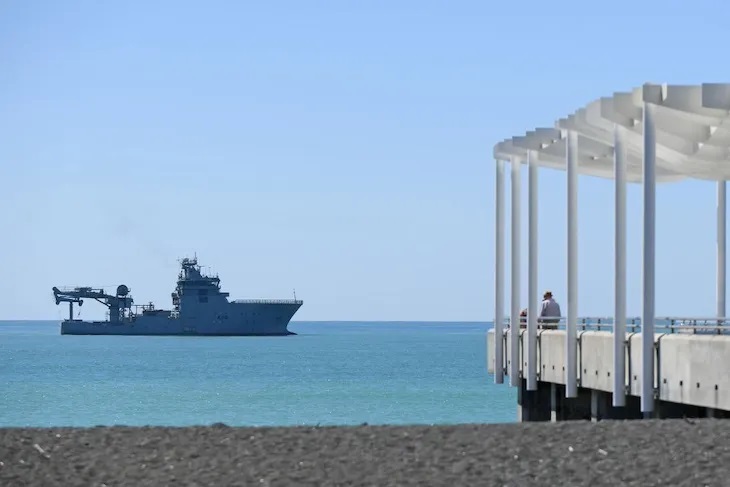New Zealand just lost one tenth of its naval defense fleet. The HMNZS Manawanui — the jewel in the nation’s small military crown — ran aground near Samoa this past weekend after hitting a reef and catching fire.
The $100 million specialist survey vessel sank on Sunday morning off Samoa’s southern coast of Upolu. An order to abandon ship was made the previous evening after it got into trouble. It was only the ship’s third deployment in the southwest Pacific, after the onetime commercial ship was purchased with much political hoopla from Norway in 2019 by the government of former prime minister Jacinda Ardern.
Arriving in the south seas, the vessel was retooled as a state-of-the-art military asset with the promise of a bright and limitless future.
On board this weekend were seventy-five personnel, including seven civilian researchers from other countries, four staffers from other militaries and the ship’s Yorkshire-born Commander Yvonne Gray.
No lives were lost in the accident, the most recent of a number of mishaps for New Zealand involving misfunctioning military assets.
A few months ago, Prime Minister Christoper Luxon nearly didn’t make it to a high-level trade meeting in Japan after the defense force plane taking him and a delegation blew a couple of fuses in Papua New Guinea and had to be grounded.
Earlier this year, Luxon also disembarked prematurely from the same plane after it broke down before leaving the tarmac in Wellington.
Defense Minister Judith Collins said at the time it was “embarrassing” that the military plane had broken down. Upgrading the defense force’s aging fleet any further, however, would have potentially cost hundreds of millions of dollars, as unaffordable a prospect for Collins’s austerity-minded government as the premiums that would have been needed to insure the Manawanui.
Collins has since indicated that power failure was the likely cause on this occasion. An inquiry has been announced into the accident, a first of its kind for New Zealand involving the peacetime loss of one of its navy ships. Among the sticky questions to be unriddled is how a high-tech ship managed to hit a reef. And, most critically, was there any contributing issue with the biofuel now seeping from the wreckage into the ocean water a nautical mile away from Samoa?
Whatever the official determination in the official inquiry, the court of online opinion was already in full swing on Monday morning.
Commander Gray, who relocated from Harrogate, North Yorkshire, to New Zealand in 2012 and took command of the Manawanui in December 2022 after stints with frigates and minehunters, has won mixed reviews for what New Zealand leaders hailed as her swift decision to abandon ship.
Posting on X, the maritime journalist and former ship captain John Konrad, author of Fire On The Horizon, said the accident could hardly have come at a worse time. The New Zealand fleet is already malnourished in the role of not only deterring China but aiding allies, providing humanitarian relief and patrolling the world’s eleventh-largest coastline and a maritime boundary two-thirds the size of the UK.
The loss of the vessel was the equivalent of the US Navy losing thirty ships. “Is that worth a few men possibly dying to protect?” Konrad asked. “Of course it is.”
Not that he was saying this captain should have sent a crew member to their probable death to save this ship. “No, but leaving a skeleton crew on for firefighting is not probable death, it’s possible death.”
Ron Mark, the former defense minister on whose watch the ship was purchased five years ago, told Radio New Zealand he felt “gutted” by the accident.
The 5,740-ton vessel had been “the Swiss Army Knife” of the country’s naval fleet, he said, the refitting of which had “astonished our partners, the audacity that we would buy a commercial vessel of that type and press it into military service.” Alas, tonight in New Zealand that decision seems more audacious than ever.
This article was originally published on The Spectator’s UK website.

























